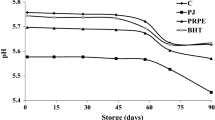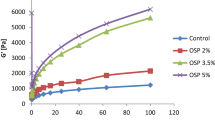Abstract
Peanut is an important crop grown worldwide. Peanut skin, the byproduct of peanut processing is a valuable byproduct due to its content of many functional components. Therefore, this study aimed to evaluate the effect of fortification of yoghurt with peanut skin extract powder (PSEP) at 50, 100 and 200 mg/L milk on the antioxidant activity (radical scavenging activity RSA%) and some quality characteristics of the resultant yoghurt during cold storage. The obtained results revealed that total phenolic content of PSEP is 109.46 mg GAE/g while it’s radical scavenging activity % reached 90.57%. Fortification of yoghurt with PSEP increased the apparent viscosity, antioxidant activity, and total phenolic, acetaldehyde, and diacetyl contents as compared to control, while the syneresis of fortified yoghurt was reduced. Microbiological analysis showed that fresh control yoghurt had the highest counts of Streptococcus thermophilus and Lactobacillus bulgaricus and decreased at the end of storage in all treatments. Both control and T1 (the low concentration of PSEP) gained the highest acceptability; therefore, it was recommended that fortification of yoghurt with 50 mg of PSEP/L is more preferable than the other concentrations. In addition, it could be considered as a natural antioxidant source in formulating functional yoghurt either in industrial and/or small industrial scale.


Similar content being viewed by others
References
Abd El-Galeel AA, El-Zahar KM (2018) production of white soft cheese fortified with natural antioxidants as a functional dairy food. Zagazig J Agric Res 45:637–656
Alenisan MA, Alqattan HH, Tolbah LS, Shori AB (2017) Antioxidant properties of dairy products fortified with natural additives: a review. J Assoc Arab Univ Basic Appl Sci 24:101–106
Arnous A, Makris DP, Kefalas P (2002) Correlation of pigment and flavanol content with antioxidant properties in selected aged regional wines from Greece. J Food Compos Anal 15:655–665
AOAC (2006) Official methods of analysis, 17th edn. Association of official analytical chemists, Washington
Arya SS, Salve AR, Chauhan S (2016) Peanuts as functional food: a review. J Food Sci Technol 53:31–41
Bertolino M, Belviso S, Dal Bello B, Ghirardello D, Giordano M, Rolle L, Gerbi V, Zeppa G (2015) Influence of the addition of different hazelnut skins on the physicochemical, antioxidant, polyphenol and sensory properties of yoghurt. LWT-Food Sci Technol 63:1145–1154
Bonku R, Yu J (2020) Health aspects of peanuts as an outcome of its chemical composition. Food Sci Human Wellness 9:21–30
Brand-Williams W, Cuvelier ME, Berset C (1995) Use of a free radical method to evaluate antioxidant activity. LWT-Food Sci Technol 28:25–30
Christman LM, Dean LL, Bueno Almeida C, Weissburg JR (2018) Acceptability of peanut skins as a natural antioxidant in flavored coated peanuts. J Food Sci. 83:2571–2577
Constanza KE, White BL, Davis JP, Sanders TH, Dean LL (2012) Value-added processing of peanut skins: antioxidant capacity, total phenolics, and procyanidin content of spray-dried extracts. J Agric Food Chem 60:10776–10783
Dalling MJ (1986) Plant proteolytic enzymes. CRC Press, Boca Raton, Florida, USA
Damame SV, Chavan JK, Kadam SS (1990) Effects of roasting and storage on proteinsand oil in peanut kernels. Plant Foods Hum Nutr 40:143–148
Davis JP, Dean LL (2016) Peanut composition, flavor and nutrition. In: Stalker HT, Wilson RF (eds) Peanuts: genetics, processing and utilization. AOCS Press, NC, USA, pp 289–345
De Camargo AC, Vidal CMM, Canniatti-Brazaca SG, Shahidi F (2014) Fortification of cookies with peanut skins: effects on the composition, polyphenols, antioxidant properties and sensory quality. J Agric Food Chem 62:11228–11235
Delgado-Andrade C, Morales FJ (2005) Unraveling the Contribution of Melanoidins tothe Antioxidant Activity of Coffee Brews. J Agric Food Chem 53:1403–1407
Driessen FM, Puhan Z (1988) Technology of mesophilic fermented milk. In: Fermented milks Science & Technology, Brussels. International Dairy Federation, International Dairy Federation Bulletin
Dwyer JT, Wiemer KL, Dary O, Keen CL, King JC, Miller KB, Philbert MA, Tarasuk V, Taylor CL, Gaine PC, Jarvis AB (2015) Fortification and health: challenges and opportunities. Adv Nutr 6:124–131
El-Abbadi NH, Dao MC, Meydani SN (1270S) Yoghurt: role in healthy & active aging. Am J Clin Nutr 99:1263S–1270S
Elsorady MEI, Ali SE (2018) Antioxidant activity of roasted and unroasted peanut skin extracts. Int Food Res J 25:43–50
Ersöz E, Kınık Ö, Yerlikaya O, Açu M (2011) Effect of phenolic compounds on characteristics of strained yoghurts produced from sheep milk. Afr J Agric Res 6:5351–5359
Goupy P, Hugues M, Boivin P, Amiot MJ (1999) Antioxidant composition and activity of barley (Hordeum vulgare) and malt extracts and of isolated phenolic compounds. J Sci Food Agric 79:1625–1634
Güler Z, Taşdelen A, Şenol H, Kerimoğlu N, Temel U (2009) The determination of volatile compounds in set-type yogurts using static headspace gas chromatographic method. GIDA/J Food 34:137–142
Guzel-Seydim Z, Wyffels JT, Seydim AC, Greene AK (2005) Turkish kefir and kefir grains: microbial enumeration and electron microscobic observation. Int J Dairy Technol 58:25–29
Hanato T, Kagawa H, Vasuhara T, Okuda T (1988) Two new flavonoids & other constituents in licorice root: their relative astringency and radical scavenging effects. Chem Pharm Bull 36:2090–2097
Isanga J, Zhang G (2009) Production and evaluation of some physicochemical parameters of peanut milk yoghurt. LWT–Food Sci Technol 42:1132–1138
Jambi HA (2018) Evaluation of physio-chemical and sensory properties of yoghurt prepared with date pits powder. Curr Sci Int 7:1–9
Joung JY, Lee JY, Ha YS, Shin YK, Kim Y, Kim SH, Oh NS (2016) Enhanced microbial, functional and sensory properties of herbal yogurt fermented with Korean traditional plant extracts. Korean J Food Sci Anim Resour 36:90–99
Karagul-Yuceer Y, Drake M (2006) Sensory analysis of yoghurt. In: Chan RC (ed) Manufacturing yoghurt and fermented milks, 1st edn. Blackwell Publishing, Oxford, UK, pp 265–278
Lees GJ, Jago GR (1969) Methods for the estimation of acetaldehyde in cultured dairy products. Aust J Dairy Technol 24(4):181–185
Lees GJ, Jago GR (1970) The estimation of diacetyl in the presence of other carbonyl compounds. J Dairy Res 37:129–132
Lee SC, Jeong SM, Kim SY, Park HR, Nam KC, Ahn DU (2006) Effect of far-infrared radiation and heat treatment on the antioxidant activity of water extracts from peanut hulls. Food Chem 94:489–493
Lorenzo JM, Munekata PE, Sant'Ana AS, Carvalho RB, Barba FJ, Toldrá F, Mora L, Trindade MA (2018) Main characteristics of peanut skin and its role for the preservation of meat products. Trend Food Sci Tech 77:1–10
Ma Y, Kerr WL, Cavender GA, Swanson RB, Hargrove JL, Pegg RB (2013) Effect of peanut skin incorporation on the color, texture and total phenolics content of peanut butters. J Food Process Eng 36:316–328
Ma Y, Kerr WL, Swanson RB, Hargrove JL, Pegg RB (2014) Peanut skins-fortified peanut butters: effect of processing on the phenolics content, fibre content and antioxidant activity. Food Chem 145:883–891
Makau JN, Watanabe K, Mohammed MM, Nishida N (2018) Antiviral activity of peanut (Arachis hypogaea L.) skin extract against human influenza viruses. J Med Food 21:777–784
Mc Cann TH, Fabre F, Day L (2011) Microstructure, rheology and storage stability of low-fat yoghurt structured by carrot cell wall particles. Food Res Int 44:884–892
O’Keefe SF, Wang H (2006) Effects of peanut skin extract on quality and storage stability of beef products. Meat Sci 73:278–286
Oliveira A, Alexandre EM, Coelho M, Lopes C, Almeida DP, Pintado M (2015) Incorporation of strawberries preparation in yoghurt: impact on phytochemicals and milk proteins. Food Chem 171:370–378
Öztürk HI, Aydına S, Sözerib D, Demircia T, Sertc T, Akın N (2018) Fortification of set-type yoghurts with Elaeagnus angustifolia L. flours: effects on physicochemical, textural, and microstructural characteristics. LWT-Food Sci Technol 90:620–626
Pagthinathan M, Nafees MSM, Powsika E (2018) Evaluate the physical, chemical and sensory parameters of probiotic yoghurt during storage. AGRIEAST 12:10–18
Peng M, Bitsko E, Biswas D (2015) Functional properties of peanut fractions on the growth of probiotics and foodborne bacterial pathogens. J Food Sci 80:M635–M641
Rawel HM, Czajka D, Rohn S, Kroll J (2002) Interactions of different phenolic acids and flavonoids with soy proteins. Int J Biol Macrom 30:137–150
Shori AB, Baba AS (2012) Viability of lactic acid bacteria & sensory evaluation in Cinnamomum verum and Allium sativum-bioyoghurts made from camel and cow milk. J Assoc Arab Univ Basic Appl Sci 11:50–55
Singleton VL, Orthofer R, Lamuela-Raventos RM (1999) Analysis of total phenols and other oxidation substrates and antioxidants by means of Folin-Ciocalteu reagent. Method Enzymol 299:152–178
Thompson JL, Lopetcharat K, Drake MA (2007) Preferences for commercial strawberry drinkable yogurts among African, American, Caucasian, and Hispanic consumers in the United States. J Dairy Sci 90:4974–4987
Yildiz G, Vatan Ö, Çelikler S, Dere S (2009) Determination of the phenolic compounds and antioxidative capacity in red algae Gracilaria bursa-pastoris. Int J Food Prop 14:496–502
Yuksel Z, Avci E, Erdem YK (2010) Characterization of binding interactions between green tea flavonoids and milk proteins. Food Chem 121:450–456
Author information
Authors and Affiliations
Corresponding author
Ethics declarations
Conflict of interest
The authors declare that they have no conflict of interest.
Additional information
Publisher's Note
Springer Nature remains neutral with regard to jurisdictional claims in published maps and institutional affiliations.
Rights and permissions
About this article
Cite this article
Hamed, A.M., Taha, S.H., Darwish, A.A. et al. Antioxidant activity and some quality characteristics of buffalo yoghurt fortified with peanut skin extract powder. J Food Sci Technol 58, 2431–2440 (2021). https://doi.org/10.1007/s13197-020-04835-2
Revised:
Accepted:
Published:
Issue Date:
DOI: https://doi.org/10.1007/s13197-020-04835-2




